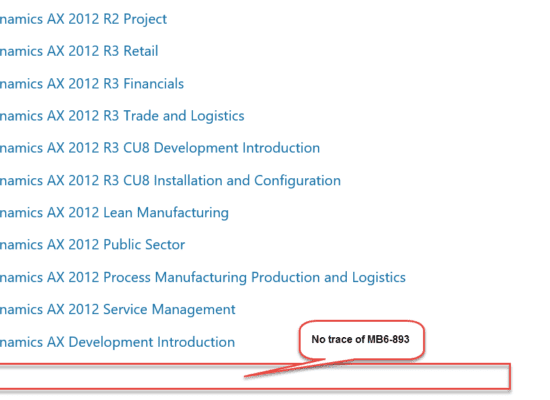
AX Distribution and Trade Certification Exam MB6-892
Note: This exam is retired.
For current exams, please read our Microsoft Dynamics 365FO Certifications and Exams Overview (axcademy.com)
Microsoft Dynamics AX Distribution and Trade Certification Exam MB6-892
This preparation guide includes information and tools to assist you in preparation for the Microsoft Dynamics AX Distribution and Trade Certification Exam MB6-892.
Target Audience
This exam is intended for partners who plan to implement, use, maintain, or support Microsoft Dynamics AX in their or their customers’ organizations. This audience typically includes Microsoft Dynamics AX partner staff, such as solution architects, functional consultants, and project managers. This exam is also appropriate for sales staff who have a business software solution background and want to demonstrate a foundational understanding of the Microsoft Dynamics AX application.
Candidates who take this exam should have a moderate understanding of distribution and trade processes. They also need an understanding of which Microsoft Dynamics AX functionalities apply to the Procure to Pay, and Order to Cash processes.
Exam Specifics
Skills being measured
This certification exam measures a candidate’s understanding of how to use, maintain, and support the supply chain and distribution and trade processes in Microsoft Dynamics AX. These modules include Inventory management, Product information management, Sales and marketing, Accounts receivable, Procurement and sourcing, and Accounts payable.
Time requirements
Microsoft Dynamics exam times typically range between 60 — 160 minutes. Note that this time does not include any additional time required for validating your identification, reviewing instructions, providing comments, and calculating your score.
Microsoft Dynamics exams typically contain between 40 – 75 questions
Multiple Choice and Multiple Answer questions
Registration
Register for Microsoft Dynamics AX Distribution and Trade Certification Exam MB6-892
Exam Preparation Tools
In addition to your hands-on experience working with Microsoft Dynamics AX, we highly recommend using the following tools and training to help you prepare for this exam:
Instructor led training
E-Learning
80740 Manage Customer Relationships in Microsoft Dynamics AX ;
80741 Manage Products and Services for Sales in Microsoft Dynamics AX;
80811 Enrich Product Data in Microsoft Dynamics AX;
80835 Control and Manage Sales in Microsoft Dynamics AX ;
80836 Manage Sales Commissions in Microsoft Dynamics AX;
80837 Create Sales Quotations in Microsoft Dynamics AX ;
80838 Perform the Sales Process in Microsoft Dynamics AX;
80839 Process Outbound Delivery and Invoices in Microsoft Dynamics AX;
80816 Customer Payment Receipts in Microsoft Dynamics AX;
80819 Bills of Exchange in Microsoft Dynamics AX;
80840 Manage Vendor Relationships in Microsoft Dynamics AX;
80841 Manage Products and Services for Procurement in Microsoft Dynamics AX;
80842 Control and Manage Purchases in Microsoft Dynamics AX;
80843 Create Purchase Requisitions in Microsoft Dynamics AX;
80844 Create Requests for Quotations in Microsoft Dynamics AX;
80845 Perform the Procurement Process in Microsoft Dynamics AX;
80846 Receive Products and Services in Microsoft Dynamics AX;
80808 Vendor Invoicing in Microsoft Dynamics AX;
80813 Vendor Invoice Journals in Microsoft Dynamics AX;
80815 Vendor Payments in Microsoft Dynamics AX;
Supplemental learning resources
TechNet; MSDN; Dynamics AX wiki maintained by the Microsoft AX community.
Additional skills recommended
Previous application experience in AX2012, AX2009, and AX4.0 will aid in understanding concepts.
Exam Topics
Set up and maintain master data for the supply chain and distribution and trade. (30% – 35%)
- Manage customer relationships
This objective may include but is not limited to: Create and maintain customer records in Microsoft Dynamics AX; configure and manage customer trade agreements; set up customer groups and posting profiles; configure credit limits. - Manage vendor relationships
This objective may include but is not limited to: Create and maintain vendor records; configure and manage vendor trade agreements; set up vendor groups and posting profiles. - Manage products and services
This objective may include but is not limited to: Create product and service items; create item groups and item model groups; create product dimensions and inventory dimension groups; track inventory using serial and batch numbers; create units of measure; create inventory and posting profiles. - Enrich product data
This objective may include but is not limited to: Set up product attributes; create and maintain product hierarchies.
Manage the sales process (25% – 30%)
- Control and manage sales
This objective may include but is not limited to: Create charges codes; create customer charges groups; create item charges groups; create delivery charges groups; create auto charges; create terms of payment. - Manage sales commissions
This objective may include but is not limited to: Create commission customer groups; create commission item groups; create commission sales groups; set up commission calculations. - Create sales quotations
This objective may include but is not limited to: Working with sales quotations; Update sales quotations. - Perform the sales process
This objective may include but is not limited to: Create sales orders; create customer sales agreements. - Process outbound delivery and invoicing
This objective may include but is not limited to: Set up warehouses; pack and ship products; post a packing slip; invoice customers; process returns from customers.
Manage the purchase process (30% – 35%)
- Control and manage purchases
This objective may include but is not limited to: Create charges codes; create vendor charges groups; create item charges groups; create delivery charges groups; create auto charges. - Create purchase requisitions
This objective may include but is not limited to: Create and submit purchase requisitions for approval; define control parameters and workflow on purchase requisition documents; set up purchasing policies. - Create requests for quotations
This objective may include but is not limited to: Process requests for quotations; reply to requests for quotations; create requests for quotations. - Perform the procurement process
- This objective may include but is not limited to: Create purchase orders; create purchase agreements; create release lines; set up and process change management.
- Receive products and services
This objective may include but is not limited to: Perform desktop receiving; create purchase invoices and match receipts; set up quality management on purchase items; inspect product receipts; receive products and return rejections; create a case for undelivered products from a vendor. - Manage vendor invoices
This objective may include but is not limited to: Set up payment schedules; manage terms of payment; create cash discounts; configure payment fees; configure vendor posting profiles; add charges on purchase order invoices; describe the types of invoice matching; perform invoice matching; create and process vendor invoices. - Manage vendor invoice journals
This objective may include but is not limited to: Describe the methods for invoicing in Accounts payable; Create and process invoice registers and approval journals; Create and process invoice journals; Create and use a voucher template in an invoice journal; Process invoice matching for vendor invoices.
Manage the payment process and cash application process (10% – 15%)
- Set up payment management
This objective may include but is not limited to: Configure methods of payments; create payment days; configure customers and vendors for payment processing; set up bank remittance; create payment fees. - Manage vendor payments
This objective may include but is not limited to: Create and process vendor payment journals; set up and process electronic vendor payments; manage vendor transactions; reverse a vendor transaction; reverse a posted payment; identify inquiries and reports in Accounts payable and their uses. - Manage customer payments
This objective may include but is not limited to: Create and process payment journals such as cash receipts; set up and process electronic customer payments; set up and generate prenotes; manage customer transactions; create and manage deposit slips; set up and use bridging accounts for posting payments; identify inquiries and reports in Accounts payable and their uses. - Manage bill of exchanges
This objective may include but is not limited to: Identify and configure journal names for bill of exchanges; configure Accounts receivable parameters for bill of exchanges; configure the setup components for bill of exchanges; process bill of exchanges.
More information about exams
View the complete list of Dynamics 365 FOE and AX Certification Exams

